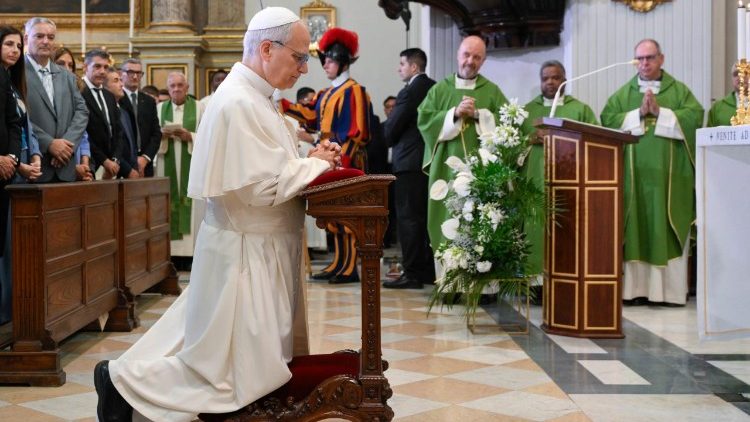
The Youth Jubilee 2025 in Rome was an event of extraordinary resonance, culminating in the solemn Eucharistic celebration at Tor Vergata presided over by Pope Leo XIV. A particularly significant moment preceding the papal meeting was the #SYMJubilee, the week animated by the Salesian Youth Movement (SYM), which ended with 5,000 young people being sent to the oratory at the Basilica of St John Bosco in Rome on 2 August 2025.
The week-long Salesian event offered young people workshops, intercultural encounters, moments of prayer and music. Sending the young people to Tor Vergata were Fr Fabio Attard, Rector Major of the Salesians of Don Bosco, and Mother Chiara Cazzuola, Mother General of the Daughters of Mary Help of Christians. The moment was sealed with a symbolic gesture of planting: biodegradable sheets containing flower seeds on which were written gestures of peace made by the young people, were planted in a vase. The central message conveyed to the young people was: ‘Be sowers of peace, reap fruits of hope’.
The Tor Vergata gathering is not only a current event, but carries with it an echo from the past, inevitably comparing itself with the Jubilee of 2000, which saw Pope John Paul II as the key player. Twenty-five years ago, the esplanade was crowded with millions of young people, the ‘Papaboys’, chanting the famous ‘Jesus Christ you are my life’. With a profound difference, however. That era was characterised by a profound optimism for the coming millennium, before the events that would profoundly mark the new century, such as 11 September 2001 and the economic crisis of 2008. Entering the new millennium, one could almost perceive a Belle Époque of the 21st century, in which faith and religious affiliation were something more evident and (almost) taken for granted, far from the threat of war and open to a possible future of hope.
The 2025 context is radically different. The youth of today are the ‘children of the youth’ of that time, many born years after the death of John Paul II and who have mostly lived with only one Pope, Francis. While they did not use smartphones in 2000, today’s young people move around with water bottles and trainers, and are accustomed to a world where ‘doing something else’ is just a click away, between the ‘reels of Instagram’ and the ‘scroll of TikTok’. The chronicles highlight (perhaps too much…) a comparison between the two eras, questioning how many of those Papaboys are still active in the faith and how the children of those Papaboys are living the experience today.
Despite the dull refrain heard all too often about empty churches, hundreds of thousands of young people from 146 countries have incurred expenses and travel costs to come to Rome. They are young people catapulted into a Western world where everything is against faith and religious practice. Generation Z, born between 1997 and 2012, shows an attraction to faith, although they do not always know how to define its connotations, and they certainly do not reject it. For this generation, faith is no longer taken for granted, but something to seek and a fact to invest in. Religious awakening, today, can begin with a video of a few seconds picked up by one’s smartphone, a ‘first step’ towards a more arduous path of encounters and friendships.
Pope Leo XIV’s reflection, in his homily at Tor Vergata, fits perfectly into this context, offering a proposal of faith that is intrinsic to the heart of the young person. Taking up the words of Pope Francis in Lisbon, the Holy Father emphasised how ‘Everyone is called to confront great questions that do not have […] a simplistic or immediate answer, but invite one to make a journey, to go beyond oneself, to go beyond […], to a take-off without which there is no flight.’ Being ‘thirsty, restless, unfulfilled, longing for meaning and for the future’ is not a sign of illness, but of life. There is an ‘important question in our heart, a need for truth that we cannot ignore’ that drives us to question ourselves on the ‘true taste of life’ and on what can free us from ‘meaninglessness, boredom, mediocrity’.
We feel a ‘great and burning thirst’ that no ‘drink of this world can quench’. Instead of deceiving the heart with ‘ineffective substitutes’, we must listen to this thirst and make it ‘a stool on which to climb to look out, like children, on tiptoe, at the window of the encounter with God’. God is waiting for us and ‘knocks gently at the window of our soul.’ It is beautiful, even in our twenties, ‘to open wide our hearts to Him, to allow Him to enter, and then to venture with Him into the eternal spaces of the infinite’.
The fullness of our existence does not depend on what we accumulate or possess, but on ‘what we know how to welcome and share with joy’. It is not enough to buy, to accumulate, to consume; it is necessary ‘to raise our eyes, to look upwards, to the ’things above‘ (Col 3:2), to realise that everything has meaning […] only to the extent that it serves to unite us to God and to our brothers and sisters in charity’.
The proposal to young people is clear and high: aspire to holiness, wherever they are, and do not settle for less. This is cultivated by remaining united with Him through prayer, adoration, Eucharistic communion, frequent confession and generous charity. Entrusting young people to Mary, the Virgin of hope, the Holy Father urges them to continue to walk joyfully in the footsteps of the Saviour and to ‘infect everyone they meet with their enthusiasm and the witness of their faith’.
The vocational call, inherent in the desire for meaning and greatness that already dwells in the heart of every young person, only awaits a proposal that matches their deepest aspirations. The hearts of young people are lit up for nothing less!
Courtesy: ANS


